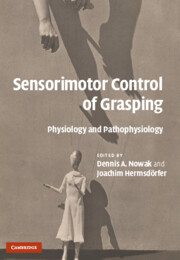Book contents
- Frontmatter
- Contents
- List of contributors
- Preface
- Part I Methodology
- Part II The physiology of grasping
- 10 The study of hand movements during grasping. A historical perspective
- 11 Sensory control of object manipulation
- 12 Predictive mechanisms and object representations used in object manipulation
- 13 The neurohaptic control of the hand
- 14 Points for precision grip
- 15 Two hands in object-oriented action
- 16 Dynamic grasp control during gait
- 17 Development of grasping and object manipulation
- 18 The effects of aging on sensorimotor control of the hand
- Part III The pathophysiology of grasping
- Part IV Therapy of impaired grasping
- Index
- Plate section
- References
13 - The neurohaptic control of the hand
Published online by Cambridge University Press: 23 December 2009
- Frontmatter
- Contents
- List of contributors
- Preface
- Part I Methodology
- Part II The physiology of grasping
- 10 The study of hand movements during grasping. A historical perspective
- 11 Sensory control of object manipulation
- 12 Predictive mechanisms and object representations used in object manipulation
- 13 The neurohaptic control of the hand
- 14 Points for precision grip
- 15 Two hands in object-oriented action
- 16 Dynamic grasp control during gait
- 17 Development of grasping and object manipulation
- 18 The effects of aging on sensorimotor control of the hand
- Part III The pathophysiology of grasping
- Part IV Therapy of impaired grasping
- Index
- Plate section
- References
Summary
Summary
Our knowledge about an object small enough to be grasped with the hand usually begins first with a visual appreciation of its size and shape. However, in the dark or when searching a deep pocket or purse, vision is impossible. Consequently a haptic exploration procedure is the only course of action and scanning an object's surface with the fingertips provides information about friction, shape, compliance, temperature and friction that is unattainable by visual inspection. This initial information is of particular importance to subsequent object manipulation and dexterous handling. Both exploratory hand movements and object manipulation make efficient use of specialized low-threshold mechanoreceptors in the skin which are selectively sensitive to both normal and tangential (shearing) forces as well as slip on the skin. This cutaneous feedback guides the exploratory movements and provides a signal of when a tactile target is encountered. These primary afferent signals are subsequently transformed by cell assemblies in the somatosensory cortex to generate central representations or internal models of the object's salient physical features. Neuronal signals encoding the internal model of shape, friction and center of mass are then relayed directly by cortico-cortical projections from the somatosensory cortex to motor cortex. The subsequent dexterous object manipulation is driven by anticipatory motor control strategies based on the internal model of the object's features which are used to direct grip forces and finger positions.
- Type
- Chapter
- Information
- Sensorimotor Control of GraspingPhysiology and Pathophysiology, pp. 178 - 192Publisher: Cambridge University PressPrint publication year: 2009

